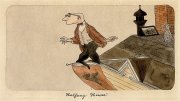The Temptation of Despair: Tales of the 1940s, by Werner Sollors, Cabot professor of English literature and professor of African and African American studies (Harvard, $35). Studying postwar Germany, where he grew up, Sollors found not the relief of liberation, but the crushed spirit (and culture) of defeat and illness in the wake of worlds destroyed.
The Architecture of Paul Rudolph, by Timothy M. Rohan, Ph.D. ’01 (Yale, $65). An art historian at the University of Massachusetts, Amherst, presents the first comprehensive review of the “brutalist” architect’s work—most famously, the corrugated concrete Yale Art & Architecture Building. Rudolph studied at Harvard with Walter Gropius, and left his mark on the Boston Government Service Center, too. Brilliantly illustrated.
How Not to Be Wrong: The Power of Mathematical Thinking, by Jordan Ellenberg ’93, Ph.D. ’98 (Penguin, $27.95). An exceptionally clear, well-written, engaging book on using math (“mathematics is the extension of common sense by other means”), for laypeople, by a University of Wisconsin-Madison professor who must be a marvel in class.
Unstoppable, by Ralph Nader, LL.B. ’58 (Nation Books, $25.99). The consumer advocate now sees right and left converging in pursuit of systemic change propelled by “the deep aversion many people have to the wars of empire and corporate control over their lives, particularly the ever-tightening influence of Big Business on the mainstream media, elections, and our local, state, and federal governments.”
The Rise of Western Power: A Comparative History of Western Civilization, by Jonathan Daly, Ph.D. ’92 (Bloomsbury, $47.95 paper). An enormous text (404 pages, nearly 200 pages of notes and sources), scaled to its enormous subject. In the end, that comes down to “the Western recipe of success—decentralized authority, the affirmation of individual rights and liberty, the pursuit of truth…, toleration of differences, the rule of law, respect for property, openness to novelty, and unimpeded access to information and knowledge.”
A Social Strategy: How We Profit from Social Media, by Mikołaj Jan Piskorski, associate professor of business administration (Princeton, $29.95). From the day the nascent LinkedIn’s founders sought him out as a faculty adviser, the author has thought about how social networks enable social needs or lower their cost. Expect the firms illustrated in his analyses, or new ones, to attract you to their webs.
Walden Warming: Climate Change Comes to Thoreau’s Woods, by Richard B. Primack ’72 (Chicago, $26). A Boston University biologist, comparing modern data to Thoreau’s meticulous observations, details a three-week shift in the advent of spring and evidence, in real time, of a world “being transformed.”
Child Migration and Human Rights in a Global Age, by Jacqueline Bhabha, professor of the practice of health and human rights (Princeton, $35). The benign title of this major work on human rights in fact describes phenomena ranging from children traveling to rejoin families who have migrated, to trafficking, smuggling, and the collateral damages of war.
Incognito: Lost and Found at Harvard Divinity School, by Andrea Raynor, M.Div. ’86 (Howard Books, $24). A highly personal passage through the school in what the author (now a hospice chaplain and spiritual counselor) describes as its free-form 1980s.
Experiencing Spirituality: Finding Meaning through Storytelling, by Ernest Kurtz, Ph.D. ’78, and Katherine Ketcham (Tarcher, $25.95). A narrative on spirituality, illustrated by snappy spiritual tales (you know, the sinner who consults his physician—not for something to strengthen his willpower, but to weaken his conscience).
Hotel Florida: Truth, Love, and Death in the Spanish Civil War, by Amanda Vaill ’70 (Farrar, Straus & Giroux, $30). A narrative of the war through the intersections among Ernest Hemingway, Martha Gellhorn, Robert Capa, Gerda Taro, Arturo Barea, and Ilsa Kulcsar, whose paths crossed at Madrid’s Hotel Florida. The Capa photos, and those by Taro, perhaps less well known today, bring back the horror, powerfully.








